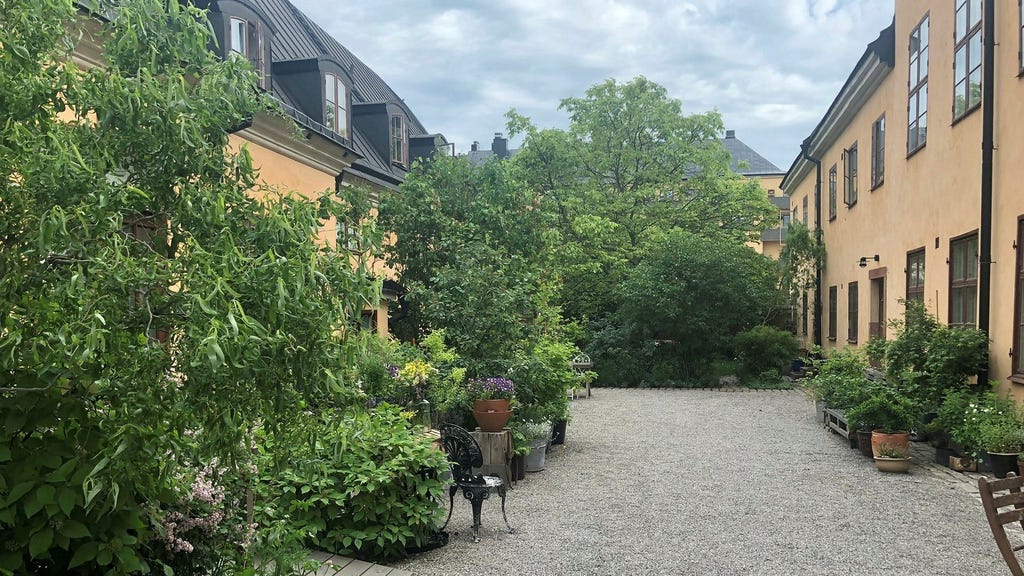A dispute has erupted in the Tegen 2 block in Stockholm, Sweden, between the landlord, Stadsholmen, and a majority of the tenants, primarily artists and artisans, over the future of the courtyard’s greenery. For over two decades, the residents of this 18th-century building, designated as a historic landmark (k-märkt), have cultivated a vibrant garden, filling the courtyard with potted perennials, shrubs, and even small trees. This organic evolution of the communal space, previously endorsed by existing guidelines, is now facing a radical overhaul dictated by the property management company. Stadsholmen asserts that the current arrangement needs “freshening up” and aims to create a more uniformly accessible and aesthetically pleasing “green oasis.”
The heart of the conflict lies in Stadsholmen’s decision to remove most of the existing plants, private decks, and outdoor furniture. While the landlord claims this action is intended to enhance the courtyard’s appeal and ensure equitable access for all residents, many tenants perceive it as an unwarranted intrusion and destruction of a cherished community asset. The artists of Södergalleriet Tegen 2, an artist-run gallery located within the building, have taken a stand against the proposed changes, organizing a group exhibition titled “Tegen tiger inte” (“Tegen does not remain silent”) to voice their concerns and gather support from fellow tenants. The exhibition serves as a platform for protest and highlights the value of the existing greenery, which provides shade, beauty, and a sense of shared ownership for the residents.
Stadsholmen, represented by Property Manager Fredrik Juhnell, has stated that a new landscaping plan will be developed in consultation with a garden coordinator and landscape architect, taking into account feedback from tenants. This plan, scheduled for implementation in the spring, focuses on establishing “new plantings in the ground for more sustainable greenery” and introducing communal furniture. Juhnell also mentioned the possibility of incorporating some of the existing plants into the new design. However, this assurance does little to assuage the anxieties of the residents who fear the loss of their carefully cultivated garden and the disruption of the established community dynamic.
While Stadsholmen claims to have received positive feedback from some tenants regarding the planned changes, the majority seem to oppose the removal of the existing greenery. Writer Peter Saemee, cited by Stadsholmen as a supporter of the changes, clarifies that his concern lies with the perceived privatization of the courtyard through individual terraces and dense plantings, emphasizing the importance of equal access for all residents. This sentiment, while valid, doesn’t necessarily represent an endorsement of Stadsholmen’s drastic approach, further highlighting the disconnect between the landlord’s intentions and the tenants’ actual concerns.
The Tegen 2 gallery, spearheaded by artist and gallerist Gunilla Sköld Feiler, has collected over 40 signatures opposing the proposed changes, demonstrating significant resistance within the community. Sköld Feiler expresses concern over the potential impact of Stadsholmen’s increased control over access to the courtyard, arguing that it undermines the gallery’s open and welcoming atmosphere. The removal of the plants outside the gallery, which provided shade and aesthetic appeal, is seen as a wasteful and disruptive act, especially given the lack of a concrete plan for the new landscaping.
The central issue in this conflict is the clash between Stadsholmen’s vision of a standardized, centrally managed courtyard and the tenants’ desire to retain the organically developed, community-driven green space. The artists of Tegen 2 and their supporters argue that the existing garden not only enhances the aesthetic appeal of the courtyard but also fosters a sense of community and belonging. They question the necessity of such a drastic intervention, advocating for a more collaborative approach that respects the existing greenery and the tenants’ invested time and effort. The dispute also raises broader questions about the balance between landlord control and tenant agency in shared spaces, highlighting the importance of communication and mutual respect in fostering a thriving community environment. The outcome of this conflict will undoubtedly shape the future character of the Tegen 2 courtyard and could set a precedent for similar disputes in other shared residential spaces.














